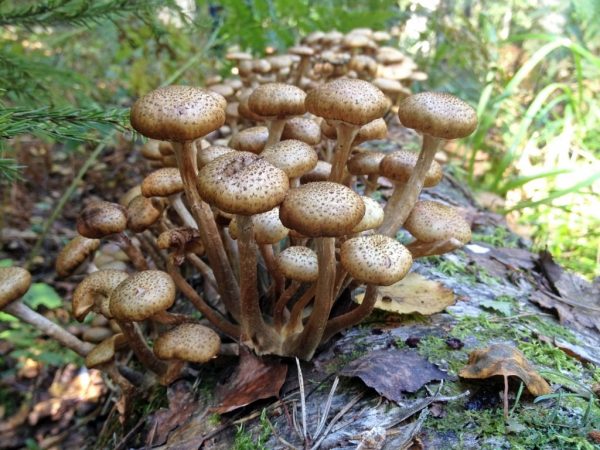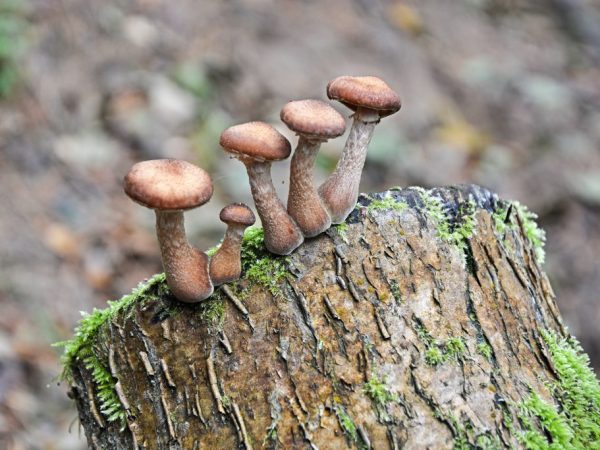Description of spruce mushrooms
In autumn, the attention of mushroom pickers is focused on small edible mushrooms on thin legs, growing in large families on old stumps, trunks of fallen trees. Spruce honey mushroom, as this mushroom is called, is loved by many forest tourists.

Description of spruce honey agarics
Description of mushrooms
Spruce mushrooms are found in pine, spruce and deciduous forests. They prefer to settle on the roots of coniferous trees, fallen trunks, fallen branches. Small thin mushrooms are found in clearings, where they cover old pine and spruce stumps with a thick head. However, the name itself tells you where to look for this delicacy.
All representatives are divided into:
- furry (spruce and autumn);
- ordinary ones with a smooth cap.
Spruce mushrooms are edible. They are easily recognizable by their dark brown caps gracefully set on thin cylindrical legs. The description of the species is in all mushroom reference books, encyclopedias. Where the darker shade comes from is understandable. The mycelium merges with the body of conifers, absorbs their bitterness.
Features:
- The cap grows from 4 to 10 cm in diameter. In young specimens, it is slightly convex in the center. The skin is covered with large scales.
- The hymenophore plates under the cap are white. In old mushrooms, they acquire a reddish tint, become covered with spots.
- The leg has a slight thickening at the base. There is a ring at the top, somewhat reminiscent of a white lace frill. The diameter of the leg is from 1 to 2.5 cm. The height is from 5 to 10 cm. The leg is dry to the touch.
- The mushroom pulp has a loose structure. It is white, slightly yellowish in color, does not have a characteristic odor.
In places where spruce mushrooms like to settle, their poisonous counterparts are often found.
It is better to go on your first forest routes with experienced people who know "by sight" the representatives of the mushroom kingdom. They will help and teach you how to navigate the mass of such mouth-watering and poisonous members of the mushroom community.
Views
Unsightly-looking mushrooms are found almost everywhere. They grow in different places, conditions. Hence the great variety of their species: meadow, summer, winter. Spruce trees are autumn species. They are easy to distinguish among all this variety by their darker shaggy hats, with edges ending in a light fringe.
Irina Selyutina (Biologist):
Spruce honey fungus is classified as an autumn species. Synonyms are often used for it: hard spruce or dark honey. Despite the low nutritional value due to the presence of bitterness in the taste ("living" on coniferous wood affects), its taste is not inferior to autumn mushrooms. In appearance, it very much resembles an edible autumn mushroom. The mycelium of dark spruce honey fungus is represented by mycelial strands, black in color, which are located under the bark and are clearly visible. In the dark, this mycelium is able to glow due to the phenomenon of bioluminescence.
Dark spruce mushrooms usually grow only in the lower part of the trunk of dead trees, but sometimes they can also be found on living trees.
The spruce mushroom is also called dark mushroom. All the rest are lighter, have a yellowish or reddish tint. For example, there is a brick-red honey fungus, seroplate, shrinking.
Beneficial features

Mushrooms are high in carbohydrates
The large amount of protein contained in mushrooms allows us to call these organisms with good reason "forest meat". Caloric content - 23 kcal / 100 g, which is quite a bit and makes them a dietary product.
Mushroom pulp is also valuable for its high carbohydrate content. A special place is occupied by glycogen, located in the form of small granules in the cytoplasm of cells. This is the main energy reserve of the mushroom. Eating mushrooms in food, we provide our body with a mass of useful substances. These are vitamins (C, PP, E and group B), trace elements (Ca, K, Na, Fe, Mg, Cu, Zn), organic acids, sugars, ash substances.
In terms of phosphorus content, spruce mushrooms overtake cow's milk, and they contain the same amount of potassium as in pears or grapes. Fiber amounts to nearly half of the dry weight (42%). The mushroom pulp tastes good. It is provided with a high content of extractives. In this respect, mushrooms gain an advantage over many foods used as food. An exception is chocolate, where the concentration of substances reaches 27%. It contains more in the leg than in the upper part of the fruiting body.
Contraindications
According to the data available to mycologists, spruce mushrooms have a firmer pulp than other species. Therefore, their use should be limited to people suffering from pathologies of the gastrointestinal tract, only 1-2 doses per week. In more severe cases, it is better to refuse them altogether.
The child should not be fed mushroom dishes at all. Chitin, which is part of the cell wall, is extremely difficult to assimilate. Sometimes even edible safe mushrooms cause severe health problems in a child.
Application
Edible mushrooms are widely used in many areas of human life. It is a valuable food product, therefore it is actively used in home cooking and food industry.
In cooking
Spruce mushrooms provide little water during cooking and are therefore ideal for frying. Sometimes the legs are too hard, then they are thrown away. Sometimes a small bitterness may be present in the fruit bodies, which the mycelium borrowed from conifers.
In this case, the mushrooms must be boiled, draining the first water (2 times / 20 minutes). After heat treatment, they are suitable for consumption. They are stewed, pickled, salted and even fermented.
In medicine
Due to its chemical composition, edible mushrooms are successfully used as an adjuvant in antitumor and antibacterial therapy. They are used to treat diseases caused by E. coli, Staphylococcus aureus. Regular use of honey mushrooms normalizes the thyroid gland. This organ regulates the most important life processes in the body.
Regular inclusion of mushroom dishes in the diet will avoid the development of many pathologies. The lecithin contained in the mushroom pulp prevents harmful cholesterol from accumulating on the walls of blood vessels (to form cholesterol plaques). Due to its low glycemic index (10), this product is included in the diet of patients with diabetes mellitus.
Growing
More and more often, artificially obtained mushrooms are found on supermarket shelves. This type of mushroom is great for mass cultivation. They are unpretentious, grow quickly and do not require large financial investments.
Artificial (if I may say so) mushrooms tolerate long-term transportation and storage well. They are elastic, do not lose their original shape and presentation. The pulp does not change its color and properties.
Conclusion
Honey mushrooms are not only tasty, but also very useful mushrooms. Be careful when collecting: false mushrooms are poisonous, they should not be eaten.
To protect yourself, it is permissible to grow mushrooms on your own: they do not require special conditions.


